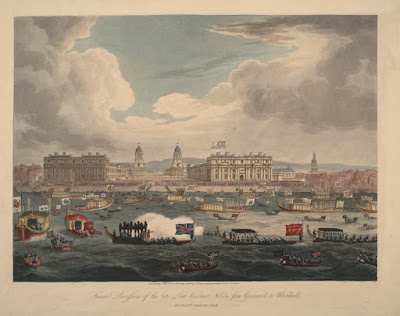The Funeral of Admiral Lord Nelson
Earlier this month, we observed the 210th
anniversary of Admiral Lord Nelson’s funeral in 1806. Two of the prints in our
new exhibit, The Face of Nelson,
depict scenes from the funeral that illustrate the lavish decorations and
attention to detail that were part of this event. HMS Victory returned to England carrying Nelson’s body on 4 December
1805. His body was placed in a wooden coffin made from the mast of L’Orient, the French flagship at the
Battle of the Nile whose explosion placed an exclamation point on one of
Nelson’s greatest victories. The Commissioner of the Sheerness dockyard
transported his coffin to Greenwich Hospital where it remained in a private
room before officially lying in state beginning on 5 January.
Funeral
procession of the late Lord Viscount Nelson, from Greenwich to Whitehall. On
the 8th of January, 1806
Engraving
by John Hill, 1806
After
a drawing by Charles A. Pugin
On
loan from the Anne S.K. Brown Military Collection, Brown University
On 8
January, the coffin was transported by the King’s Barge up the Thames River to
Whitehall Steps. Spectators lined the shore to watch as a two-mile procession
of boats followed the barge. Admiral of the Fleet Sir Peter Parker served as the
Chief Mourner. The next day, the citizens of London turned out in the thousands
to watch the funeral procession march from the Admiralty at Whitehall to St.
Paul’s Cathedral. The procession included royalty, nobles, ministers,
high-ranking military officers and at least 10,000 soldiers. Nelson’s body rode
in an ornate funeral car that invoked the likeness of HMS Victory and carried trophies from some of the ships he defeated in
battle.
An exact
representation of the grand funeral car which carried the remains of Lord
Nelson to St. Paul’s on Thursday, January 9th 1806Aquatint,
c.1806
Artist
unknown
On
loan from the Anne S.K. Brown Military Collection, Brown University
The funeral service itself was attended by 7,000 people
including 7 royal dukes, 16 earls, 32 admirals and over 100 captains together
with 48 seamen and 12 marines from HMS Victory. The five-hour
service concluded with Nelson’s coffin being lowered into a marble sarcophagus that
was originally intended for Cardinal Wolsey, Archbishop of York and one-time
Lord Chancellor to King Henry VIII.
The Face of Nelson
is on display now at the Naval War College Museum and runs through 30 September
2016.
Rob Doane
Naval War College Museum Curator




Comments
Post a Comment